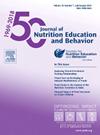难民和移民参与者的WIC福利赎回模式及不赎回相关因素
IF 2.3
3区 医学
Q2 EDUCATION, SCIENTIFIC DISCIPLINES
引用次数: 0
摘要
妇女、婴儿和儿童特殊补充营养计划(WIC)的难民和移民参与者很可能没有充分赎回和利用福利。确定低赎回食物类别和驱动低赎回的因素可以指导未来的干预措施。目的探讨具有难民和移民身份的犹他州WIC参与者如何赎回他们的WIC福利以及与中高不赎回相关的因素。研究设计、设置、参与者对137个参与家庭在2020年至2023年期间未识别的犹他州WIC行政数据进行分析。可测量的结果/分析对15个wic批准的食品组在35个月内的发放和赎回数据进行核对,估计每个家庭每月的差异。计算每个食物组的每月不赎回率。然后将食物组分为高(>50%),中等(20-50%)和低(<;20%)不可赎回率。在回归分析中,使用人口统计变量,如收入、家庭规模、母亲教育程度和原籍,对2023财政年度(n=126)的高和中等非赎回率类别评估与非赎回率相关的因素。结果高非赎回食物组为:大豆饮料、鱼类、婴儿肉类、婴儿水果和蔬菜(F&;V)、婴儿谷物、奶酪、早餐谷物、豆类、全谷物;适度的有:酸奶、牛奶、果汁;低的是:食品、鸡蛋、婴儿配方奶粉。母亲的教育程度和出身是婴儿食品、婴儿谷物、奶酪和全谷物的不赎回相关的因素。原产地与果汁和酸奶的不可兑换有关。结论难民和移民在WIC食品群体兑换方面存在差异,某些项目的不兑换率较高。母亲的教育和出身会影响福利赎回模式,这表明有针对性的干预措施,如针对文化的营养教育、社区外展计划和帮助了解福利的使用,可以增强这一人群的福利赎回。资助塔州立大学内部资金本文章由计算机程序翻译,如有差异,请以英文原文为准。
Patterns of WIC Benefits Redemption and Factors Associated with Non-redemption Among Refugee and Immigrant Participants
Background
Refugee and immigrant participants in the Special Supplemental Nutrition Program for Women, Infants, and Children (WIC) are likely to under-redeem and under-utilize benefits. Identifying low-redemption food groups and factors driving low-redemption can guide future interventions.
Objective
Examines how Utah’s WIC participants with refugee and immigrant status redeem their WIC benefits and factors associated with moderate to high non-redemption.
Study Design, Settings, Participants
Analysis of de-identified Utah WIC’s administrative data from 2020 to 2023 among 137 participating families.
Measurable Outcome/Analysis
Issuance and redemption data over 35 months were reconciled for 15 WIC-approved food groups, estimating the monthly difference per family. The monthly non-redemption rate was calculated for each food group. The food groups were then categorized into high (>50%), moderate (20-50%), and low (< 20%) non-redemption rates. In regression analyses, factors associated with non-redemption rates were assessed for high and moderate non-redemption rates categories for the 2023 fiscal year (n=126) using demographic variables such as income, household size, maternal education, and origin.
Results
High non-redemption food groups were: soy-based beverage, fish, infant meat, infant fruits and vegetables (F&V), infant cereal, cheese, breakfast cereal, legumes, whole grains; moderate were: yogurt, milk, juice; and low were: F&V, eggs, infant formula. Maternal education and origin were factors associated with non-redemption for infant F&V, infant cereal, cheese, and whole grain. Origin was linked to non-redemption for juice and yogurt.
Conclusions
Disparities exist in WIC food group redemption, with certain items having high non-redemption rates among refugees and immigrants. Maternal education and origin influence redemption patterns, indicating that targeted interventions such as culturally tailored nutrition education, community outreach programs, and assistance with understanding benefit usage could enhance benefit redemption among this population.
Funding
Utah State University Internal Funds
求助全文
通过发布文献求助,成功后即可免费获取论文全文。
去求助
来源期刊
CiteScore
4.20
自引率
11.50%
发文量
379
审稿时长
44 days
期刊介绍:
The Journal of Nutrition Education and Behavior (JNEB), the official journal of the Society for Nutrition Education and Behavior, is a refereed, scientific periodical that serves as a global resource for all professionals with an interest in nutrition education; nutrition and physical activity behavior theories and intervention outcomes; complementary and alternative medicine related to nutrition behaviors; food environment; food, nutrition, and physical activity communication strategies including technology; nutrition-related economics; food safety education; and scholarship of learning related to these areas.
The purpose of JNEB is to document and disseminate original research and emerging issues and practices relevant to these areas worldwide. The Journal of Nutrition Education and Behavior welcomes evidence-based manuscripts that provide new insights and useful findings related to nutrition education research, practice and policy. The content areas of JNEB reflect the diverse interests in nutrition and physical activity related to public health, nutritional sciences, education, behavioral economics, family and consumer sciences, and eHealth, including the interests of community-based nutrition-practitioners. As the Society''s official journal, JNEB also includes policy statements, issue perspectives, position papers, and member communications.

 求助内容:
求助内容: 应助结果提醒方式:
应助结果提醒方式:


